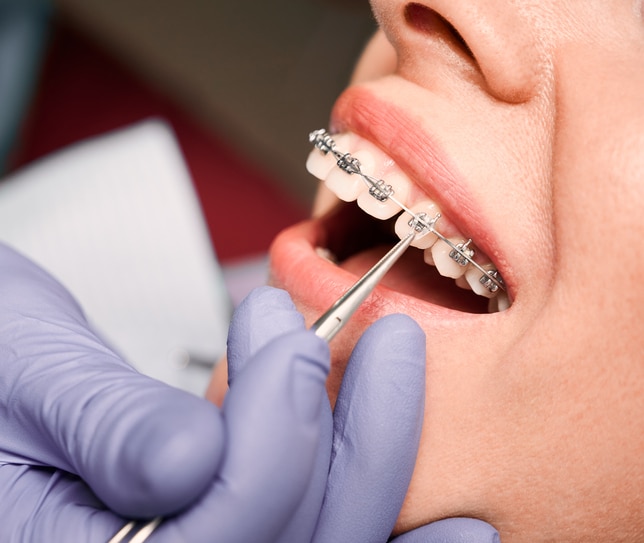Finding the Right Cumming Orthodontist for Your Braces and Aligners Needs
Finding the Right Cumming Orthodontist for Your Braces and Aligners Needs
Blog Article
Comprehensive Guide to Orthodontics Treatments for Fixing Oral Misalignments
In the world of orthodontics, the journey to attaining a completely straightened smile involves a myriad of procedures customized to remedy oral imbalances. From traditional braces to undetectable aligners and also medical alternatives, the area of orthodontics offers a variety of options to resolve varying degrees of dental irregularities. Comprehending the details of each procedure, including their systems, benefits, and prospective disadvantages, is crucial in making informed decisions concerning one's orthodontic therapy. As we navigate with the detailed overview to orthodontic procedures for fixing dental misalignments, the elaborate details of each method will unravel, clarifying the course toward a harmonious and functional oral placement.
Orthodontic Procedures Introduction

In enhancement to conventional dental braces and clear aligners, orthodontists may likewise advise other treatments like headgear, palatal expanders, or retainers to attend to details positioning concerns (cumming aligners). These treatments are customized to each individual's distinct demands and may involve a combination of therapies to attain the desired results. Routine adjustments and monitoring are crucial parts of orthodontic therapy to guarantee progression is on track and to make any type of essential adjustments in the process. By undergoing orthodontic procedures, individuals can not just attain a straighter grin but also enhance their general dental wellness and feature.
Standard Dental Braces: Exactly How They Function
When considering orthodontic therapies for dental imbalances, typical dental braces stand apart as a time-tested approach for fixing teeth positioning. Traditional dental braces contain brackets, cords, and bands that interact to use constant pressure on the teeth, gradually relocating them into the desired placement. The braces are affixed to the teeth using a special adhesive, and the cords are threaded via the braces. By adjusting the stress of the wires, orthodontists can regulate the direction and force related to each tooth, guiding them right into correct positioning with time.
As stress is used to the teeth via the dental braces, the bone surrounding the teeth is reshaped to support the brand-new tooth placements. Patients will require normal modifications at the orthodontist's workplace to make certain the dental braces proceed to use the right stress for reliable teeth motion.
Undetectable Aligners: Benefits And Drawbacks
These clear, personalized trays are essentially invisible when put on, making them an appealing alternative for individuals looking for a more cosmetically pleasing orthodontic therapy. People can eliminate the aligners prior to eating or cleaning their teeth, reducing the threat of food getting stuck in the home appliance and simplifying the cleaning procedure.

Surgical Orthodontic Options
Surgical treatments in orthodontics existing sensible alternatives for resolving intricate oral imbalances that might not be effectively fixed with traditional orthodontic treatments. While invisible aligners and traditional dental braces can remedy lots of orthodontic problems, certain cases call for medical intervention to attain optimum results. Surgical orthodontic options are typically advised for serious malocclusions, considerable jaw discrepancies, and instances where the underlying bone framework needs alteration to accomplish proper placement.
One typical surgical orthodontic treatment is orthognathic surgical treatment, which entails repositioning the jaws to correct useful problems such as difficulty talking or chewing. This surgical procedure is typically performed in partnership with an orthodontist who aids align the teeth prior to and after the procedure. Surgical orthodontics might also include procedures to subject impacted teeth, eliminate excess periodontal tissue, or improve the additional resources jawbone to create an extra harmonious facial account.
Before thinking about surgical orthodontic choices, people go through a comprehensive examination to determine the need and potential advantages of such treatments. orthodontics. While surgical treatment may seem challenging, it can dramatically improve both the feature and aesthetic appeals of the smile in instances where conventional orthodontic treatments drop short
Retainers and Post-Treatment Care

Failure to comply with post-treatment care instructions can result in regression, where the teeth progressively relocate back in the direction of their original settings. Constant retainer wear, great oral hygiene, and normal oral examinations are vital for preserving the results achieved via orthodontic surgical procedure and making certain the long-lasting stability of the fixed dental alignment.
Verdict
To conclude, orthodontic treatments use different choices for fixing oral imbalances. Standard dental braces use metal braces and cables to move teeth into proper alignment. Invisible aligners offer a more discreet alternative however may not appropriate for all situations. Surgical orthodontic options are readily available for extra extreme misalignments. Retainers are frequently utilized post-treatment to maintain the new alignment. Generally, orthodontic procedures can efficiently boost oral health and wellness and visual appearance.
As we navigate via the detailed guide to orthodontic treatments for fixing oral misalignments, the complex details of each technique will certainly unfold, dropping light on the course toward a useful and harmonious dental placement. - cumming aligners
One of the most typical orthodontic therapies is the usage of braces, which are composed of steel brackets and wires that apply mild stress to progressively shift teeth into the desired position.When taking into consideration orthodontic treatments for oral imbalances, typical dental braces stand out as a time-tested method for dealing with teeth placing. Furthermore, invisible aligners may not find out here now be suitable for complex orthodontic issues that need more significant teeth movement, as they are usually suggested for moderate to moderate cases. Retainers are tailor-made orthodontic gadgets developed to hold teeth in their fixed positions after the completion of orthodontic therapy.
Report this page